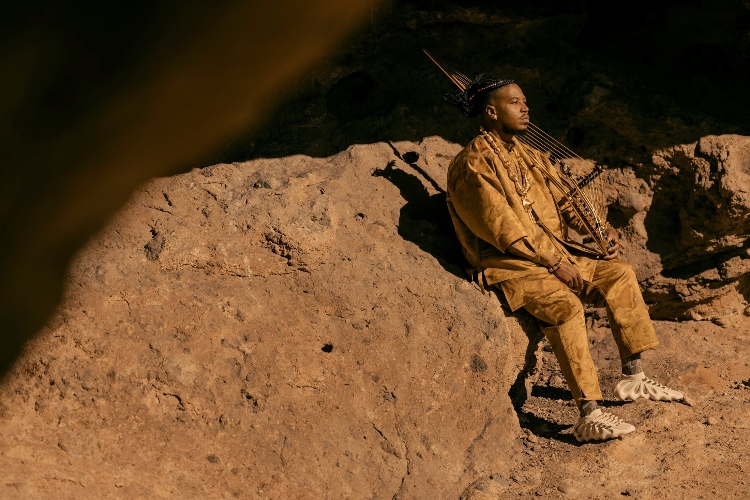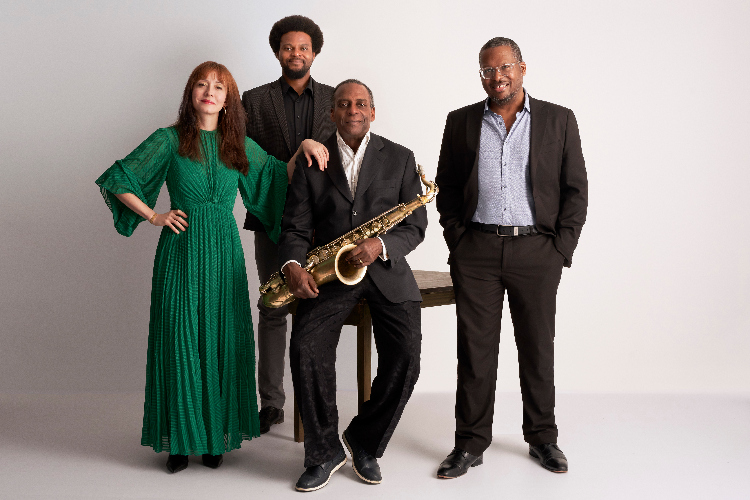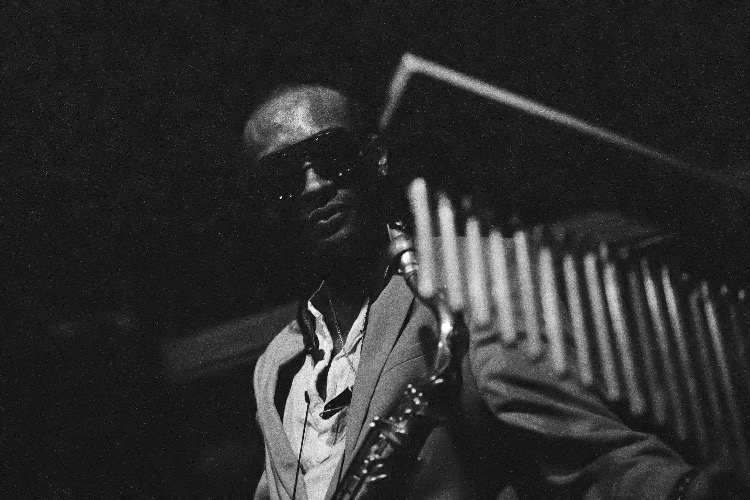Past, Present, and Future: A Conversation with Chief Xian aTunde Adjuah, Chieftain of the Xodokan Nation of Maroons and Grand Griot of New Orleans (Part Two)
|
Getting your Trinity Audio player ready...
|
We continue our conversation (read part one here) with Chief Adjuah, formerly known as Christian Scott, by discussing the connections between Afro Indigenous music and R&B, rock, and hip hop. We also get into the social messages in his music and the origins of the Adjuah Bow, his custom made kamele n’goni gravi-hybrid.
PostGenre: Although Maroon communities are undermined, their influence still impacts more prominent popular culture. One fascinating thing is how much Nation music goes into R&B. A great example would be “Iko Iko”, which is on Bark Out Thunder Roar Out Lightning, but best known for The Dixie Cups’ version. You have also incorporated more contemporary R&B music into your music in the past. Do you see a connection between Afro Indigenous music and the R&B things you use on an album like Stretch Music (Ropeadope, 2015)?
Chief Adjuah: Yeah. Well, I would say that even if we separate Stretch Music out for a minute, I think the larger point in terms of the narrative disseminated to people about how the music grew in New Orleans is missing important parts. It has massive holes in it. [The narrative] is that all this music was born from slaves, they were having a bad time, and they had to sing the Blues. And then it grew.
But that’s not what the hell happened in New Orleans. The reason this music was born there is because the African retention there is higher than in other places. It doesn’t mean it’s better. If they had been able to hold to their rhythmic traditions and play drums in places like Houston, Texarkana, or Mobile, Alabama, we would be having this conversation about those places.
New Orleans is special as one of the only holdouts in North America that specifically allowed the use of the drumming and other cultural elements that the Africans brought into Louisiana to persist. But it also has something else that is a much larger indicator of why you still have the music. It has a Maroon system, which means they went where they wanted. They did what they wanted. They were what they wanted. They spoke what they wanted to speak. They sang what they wanted to sing. The idea that this music just appeared out of people who were downtrodden and hopeless takes the power out of people’s agency to create their own freedom. There was some radical shit that’s actually built out of people willing to take action to effectuate the reality they want.
The culture held onto the skeleton keys of African expression, which eventually turned into Afro-American expression, and co-mingled with other contexts. Those people were the folks that came into Congo Square to lead the processionals. Sidney Bechet talked about his grandfather, Omar as one of them. People like Omar were the prototypical musicians who built and held onto the skeleton keys of expression. They were men who would cut your throat if you tried to infringe on their freedom. They weren’t playing around either. These are Maroon people.
So to me, when we speak about [Afro Indigenous] music or when we speak about the Blues in Louisiana and the Mississippi Delta, or rhythm and blues, it is all from New Orleans. R&B and rock and roll are both from New Orleans. Other places look at that music and broadly characterize it as general American music. But the New Orleanian musicians and historians know they came from New Orleans. And they can prove it because all of the records were made here by New Orleanian musicians.
It’s not my contention that Black Indian music has a relationship to R&B and rock. I contend that Black Indian music is the actual root of those forms of music. We have a term, “bellaca,” which is related to the word “bellicose.” It is another synonym for free people, as is a word like “cimarrón”, which turned into “Maroon.” “Bellaca” is, basically, a wild runaway or free person like a Maroon, but it also has an overt kind of energy to it. Sexiness and swag as well. The music that comes out of that kind of energy forms what we now look at as rock and roll. I don’t divorce any of those things. And in terms of the connectedness [of more contemporary music] and its rootedness to actual old world music, that comes in through the Africans and what eventually ended up being the African citizenry in those places.
If we’re being honest, the rhyming thing in hip hop also has a root in Maroon music. We can’t completely divorce all things. We know where hip hop comes from on a general level. But if we’re dealing with themes of black men speaking their prowess and what they’re actualizing, it’s a commonality. Those things in hip hop are connected to African systems of honor that are placed in different ways. So, these [rapper] dudes talking about how bad they are, how they’re not taking any shit, how pretty they are. It’s all tied to the swag and the different things expressed in Maroon music since the Seventeenth Century. There is a synergy to all of those things.
PG: Throughout your career, you have not shied away from social justice messages, with songs like “K.K.P.D.” or “James Crow Jr., Esq.” Do you find that pulling in more ancient ideas helps you better address contemporary issues? The title track to Bark Out Thunder Roar Out Lightning has a very obvious social message.
CA: Oh, yeah. Well, I think connecting back to more ancient ideas shows you that none of the issues we’re dealing with are new. Many of the issues we’re talking about are just human issues. My issue is not with one thing. It’s not like I’m looking at the larger system and saying what is the enemy and what is not. The point is that we all, as human beings, need to figure out a way to be able to get on together because we can destroy this place. And it’s beautiful here, so I don’t want that.
The idea is to find a way to foster the ability to more effectively communicate why we should treat each other with respect and why we all need to comport ourselves with love and adoration, even in moments where it’s trying. The connectedness of those things is beyond beautiful. Every generation, a new group of people is born. They must be guided to not have some of those issues. When you and I are long gone, there’s going to be somebody singing about some of the problems I’m talking about and intimating right now.
Using music to express these issues creates a moment of connection with the listener. It also creates some levity to not take yourself so seriously. To let you take a step back and say, “OK, you know, I’m actually one of many, and this is part of what I see as my purpose.” I want to try and move that forward to the best degree I can. It is important to know that I’m not on an island. Someone spewing vitriolic, hateful shit is also not on an island by themselves. I think we need to work towards creating a society that, at a minimum, can reference each other’s humanity as a baseline. I’m not gonna stop doing that. If my instruments help bolster those arguments, then bring them on.
PG: So, in terms of your instruments, Bark Out Thunder Roar Out Lightning features you on the Adjuah Bow. One might wonder if part of why you created the instrument was to better escape concepts of Western European music historically associated with the trumpet. But you are saying that the bow was not designed as a means to escape Western European influence?
CA: No, not so much escaping. Don’t get me wrong, I think there are some beautiful utilities to [the Western European method] of thinking and music. We also have some pretty rigorous classical music traditions in New Orleans. If you’re a young person who’s very serious about music, at some point you’re gonna sit down with someone who shows you [Niccolò Paganini’s] “Merchant of Venice.” You’re gonna have to learn this music to truly express everything that you want to express.
But I think the issue is always that any time you exclusively think about one box, you’re gonna have problems trying to communicate with other people. To me, music is about communication; about trying to effectively communicate one human experience to other human beings so everyone can end up in another space. Hopefully, a better space. It’s difficult to do that if you refuse to acknowledge that the people you’re speaking to have their own cultural validity. I contend that music shouldn’t be exclusively anything. Don’t favor one thing over another if you want to make music that is not deficient.
As far as the bow, that instrument is only the beginning. There will be more instruments to come. The bow was created as a means to figure out how to tap into more ancestral recall for children who are learning music here. It can be very difficult for younger children from other cultures to learn to play classical music or concert music. What’s conveyed to them is that they don’t have the same type of capacity or the same bandwidth, but it’s simply because it’s not their culture. Far too often, children from around the world are told they are doing something wrong when it is just a cultural difference. I’ve witnessed people telling young children from other communities that their ability to play classical music is not going to be as high as someone born in Germany or Italy. I’ve heard those kinds of things in master classes and at all educational levels, from elementary school to college.
PG: That’s horrible.
CA: It is. Not everyone is calibrated in a way where they want to sit through that. What I saw was many young musicians with a lot of potential and talent who were pushed away from music by bigoted adults. We need to create alternatives that support these young musicians. With instruments like the Adjuah bow, we are embarking on creating twenty-first-century musical instruments that are corollaries to older things. Instruments that also allow the ancestral methodology to continue. That was one of the primary reasons behind the Adjuah bow and the other instruments we are creating.
PG: What are the other reasons?
CA: Well, the second pillar was to create instruments that also allowed you to more readily tap into the Blues element in the music. For me, when I listen to music, the Blues is a primary emotive engine. When I say the Blues, I don’t mean the music by people like Charlie Patton, Son House, or Muddy Waters over everything else. When I say the Blues, I mean human beings attempting to, as honestly, earnestly, and truthfully as possible, compel through their own experience.
That energy has a sound. Sometimes, there are harmonic markers for sound. Other times, they’re more emotive markers. But the point is that the Blues has a sound. The reason some of the great modern music has survived and is so killing is because the musicians have never disconnected themselves from [the Blues]. When you listen to Thom Yorke, you’re listening to a dude who understands the Blues and rhythm. You can sit down with him and play him a deeply African ritual practice rhythm, and he will understand exactly what’s going on.
But when I listen to most newer music, I don’t hear the Blues. I felt it was necessary to create musical instruments that can connect us to the modern era while simultaneously taking us to the older root culture where they came from. So, now, we’re building our company and creating a ton of really cool instruments that also touch other cultures from places like Madagascar, Tanzania, and Uganda. Rather than me saying “OK, let me build a twenty-first-century version” of one of the traditional instruments, we are bringing in master-level practitioners from those cultures of music to build the next lines of instruments for those spaces. That is the most fun part of the journey we’re embarking on right now.
PG: Tied to the Blues, Bark Out Thunder Roar Out Lightning includes a version of “Shallow Water” dedicated to your grandfather, Chief Donald Harrison, Sr., founder of Guardians of the Flame. Your grandfather recorded a great version of “Shallow Water” on your uncle, Chief Donald Harrison, Jr.,’s Indian Blues (Candid, 1992). Do you see Bark Out Thunder Roar Out Lightning as a continuation of Indian Blues?
CA: Absolutely. I think none of the music I have made can be divorced from what Donald has contributed. We learned from him how to fuse musical ideas. Stretch Music wouldn’t exist without Donald’s Nouveau Swing. Folks like me, Luques Curtis, and Joe Dyson learned how to stretch music from Donald. Donald was the architect and innovator of doing it that way. Once my grandfather passed, Donald also became my chief. It is impossible to separate what he contributed from what we’re doing because he is one of the main pillars.
Thank you for asking about Indian Blues. Too often, people leave that out of the equation. Indian Blues is the one bro. It was the first album to point to the fact that the stuff many people call “jazz” actually comes from the Maroon community. You can hear where swing is actually coming from – Black Indian and Afro-Indigenous people.
Bark Out Thunder Roar Out Lightning is out now on Ropeadope Records/Stretch Music. It can be purchased on Bandcamp. More information on Chief Adjuah may be found on his website.
Photo Credit: Eric Ryan Anderson




One thought on “Past, Present, and Future: A Conversation with Chief Xian aTunde Adjuah, Chieftain of the Xodokan Nation of Maroons and Grand Griot of New Orleans (Part Two)”